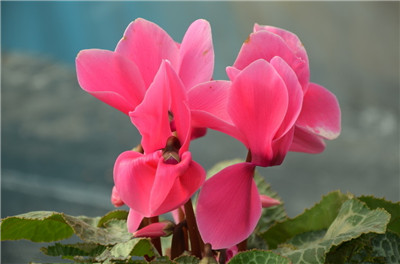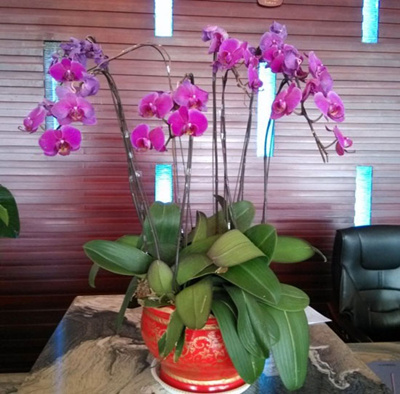How to make butterfly orchids bloom more and better!
1. The flower bud differentiation of Phalaenopsis should have a fixed annual accumulated temperature and a short period of low temperature treatment. Low temperature treatment began from 110 to 140 days before flowering, and the light intensity should be gradually increased in the first month before treatment to accumulate sufficient nutrients for flower bud differentiation. The foliar surface should be sprayed with 100-fold liquid potassium hydrogen phosphate once or twice in 7-10 days before treatment.
2. The suitable daily temperature of low temperature treatment is 2527 degrees and the night temperature is 15,18 degrees, which should ensure good ventilation. Nitrogen, phosphorus and potassium (9:45:15) quick-acting liquid fertilizer should be applied before flower bud germination, and then nitrogen, phosphorus and potassium (10:30:20) quick-acting liquid fertilizer should be sprayed on the leaf and root after the flower bud is drawn to 1520 cm, and applied once every 10 days.
3. During the flowering period, the ventilation should be strengthened, the air humidity should be reduced, and the water supply of the root system should be increased to ensure the flower size.

How to make butterfly orchids bloom more and better? 1. During the flower bud differentiation of Phalaenopsis, the temperature should be below 18 ℃, and the temperature should be increased after differentiation in order to promote flowering. Low temperature treatment generally began from 110 to 140 days before flowering, and the light intensity should be gradually increased one month before treatment to accumulate sufficient nutrients for flower bud differentiation. The foliar surface should be sprayed with 100-fold liquid of potassium dihydrogen phosphate once or twice in 7-10 days before treatment. 2. The suitable daily temperature of low temperature treatment is 2527 degrees and the night temperature is 15,18 degrees, which should ensure good ventilation. It is necessary to apply nitrogen, phosphorus and potassium (9:45:15) quick-acting liquid fertilizer before flower bud germination, and then apply nitrogen, phosphorus and potassium (10:30:20) quick-acting liquid fertilizer after the flower bud is drawn to 15-20 cm, concentrated on the leaf and root, once every 10 days, less light fertilizer. 3. At flowering stage, ventilation should be strengthened, air humidity should be reduced, and water supply of roots should be increased to ensure that the flowers are of the same size. 4. increase light, Phalaenopsis needs scattered light throughout the year, and a little artificial supplementary light can be given in winter to help it blossom; it needs a temperature of more than 20-24 ℃ throughout the year, and when it is high temperature, it is necessary to spray more water every day, preferably in the morning, the water can be completely absorbed before night, and the leaves and petioles will not stay stagnant overnight, otherwise it is easy to cause disease. Winter is also prone to frostbite, and even cause fallen leaves. 5, Phalaenopsis in different seasons, water management measures are different; different cultivation media, water management methods are also different. Because the leaves of Phalaenopsis are thicker, there is more water in storage, and the drought tolerance is strong. The air humidity is high in spring and can be watered every 3-7 days. In summer and autumn, the ambient temperature is high and water evaporation is large, usually once every 1-2 days. In winter, the air temperature is low and the air humidity is low, so it can be watered once a week. Under the condition of ensuring a certain humidity of the environment, it is necessary to avoid stagnant water in leaves, which can easily lead to frostbite. If there are conditions, it is best to force ventilation after watering, so that the stagnant water on the leaf surface is lost as much as possible, so as to reduce the occurrence of diseases. 6. in order to promote its blooming, some liquid fertilizer can be sprayed on the leaves and roots during the growing season. I fertilizer is usually applied every 3 to 4 weeks in spring. Stop fertilizing during flowering and apply fertilizer every 10 days after flowering. Fertilization is mainly liquid fertilizer with high content of phosphorus and potassium, which should be applied less and lightly each time. Phalaenopsis grows vigorously in summer. Solid organic fertilizer can be applied once in the basin, and then liquid fertilizer will be applied I times a week. The cool weather in autumn decreases gradually, and fertilization can be stopped by the end of October. The flowering period of Phalaenopsis is longer. If the pedicel is cut off in the early stage, it can blossom for the second time in the same year. Phalaenopsis with different varieties, flowering time is also different, generally each pedicel can grow more than a dozen flowers, from bottom to top one by one, a flower can bloom for more than a month. Conclusion: the above is the introduction of the knowledge about the flowering of Phalaenopsis. I hope you can exchange more experience in planting Phalaenopsis. How to make butterfly orchids bloom more and better
Maintenance skills:
In general, the new flower buds of Phalaenopsis need to be cultured for 3 months before germination to provide the possibility for flowering.
The main reason for the effect of temperature on flower bud differentiation and formation of Phalaenopsis. Not only a certain annual accumulated temperature is needed, but also a short-term low temperature treatment is needed.
In order to make flower buds differentiate normally, it is necessary to keep the cultivation environment at 15-18 ℃ at night after the arrival of late autumn. Then the seedlings need to be treated with low temperature for about 18 hours every day for one and a half months, so that the plants can sprout a lot of flower buds.
Next, the night temperature should be kept within 18-20 ℃, and bright flowers will bloom after 3-4 months of growth.
Because Phalaenopsis has a long flowering period, the pedicels are cut off in the early stage to make cut flowers, which can blossom for the second time that year.
Of course, the flowering time of different varieties of Phalaenopsis is also different, usually each pedicel can bloom more than a dozen flowers, blooming in turn from the bottom up, and each branch can bloom for more than a month.
In order to make the flowers bloom more luxuriantly, liquid fertilizer can be used to spray the leaves and roots during the peak growth period.
Fertilization is usually applied every 3-4 weeks in spring. After entering the flowering stage, fertilization stops, and fertilization can be applied every 10 days after falling flowers. The liquid fertilizer with high content of phosphorus and potassium should be selected, the amount of fertilizer should be less and the concentration should be light.
Summer is the peak growing season for Phalaenopsis. After applying solid organic fertilizer once in the basin, liquid fertilizer can be applied once a week.
Fertilization also decreased with the decrease of temperature in autumn, and stopped after the end of October.
- Prev

How to buy high quality cyclamen
Cyclamen beautiful plant type, unique, colorful flowers, rich fragrance, combined with the role of purifying the air, so that it is very popular in the flower market, when buying cyclamen, pay attention to the following: 1, purchase time: cyclamen is a cool flower, flowering for winter and spring, is the best viewing period
- Next

How to grow Phalaenopsis when it blossoms?
Phalaenopsis is a very popular holiday flower. Phalaenopsis has already bloomed when many flower friends buy it, but I don't know how Phalaenopsis is in bloom. There are indeed a lot of things to pay attention to in the maintenance of Phalaenopsis flowering. When Phalaenopsis blossoms, the plant is dormant or semi-dormant. Never water it.
Related
- Fuxing push coffee new agricultural production and marketing class: lack of small-scale processing plants
- Jujube rice field leisure farm deep ploughing Yilan for five years to create a space for organic food and play
- Nongyu Farm-A trial of organic papaya for brave women with advanced technology
- Four points for attention in the prevention and control of diseases and insect pests of edible fungi
- How to add nutrient solution to Edible Fungi
- Is there any good way to control edible fungus mites?
- Open Inoculation Technology of Edible Fungi
- Is there any clever way to use fertilizer for edible fungus in winter?
- What agents are used to kill the pathogens of edible fungi in the mushroom shed?
- Rapid drying of Edible Fungi

